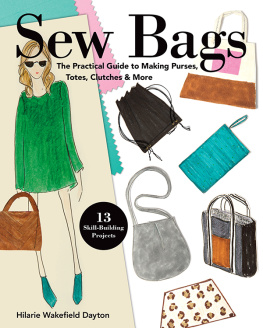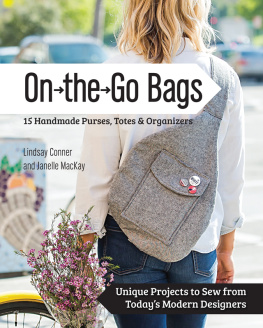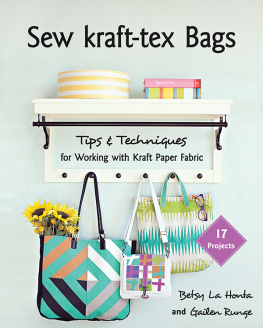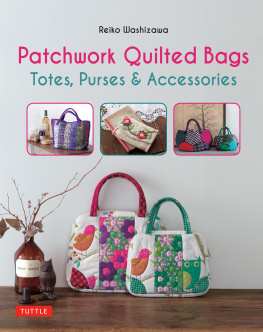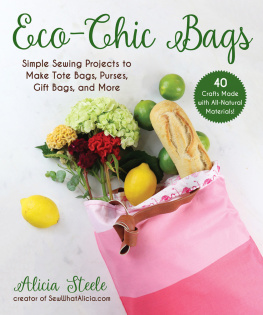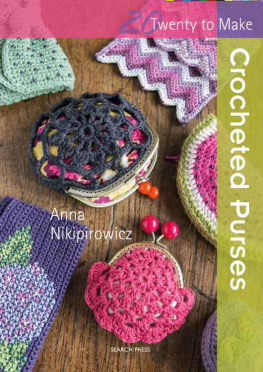Elsie Mochrie - Leather Bags and Purses
Here you can read online Elsie Mochrie - Leather Bags and Purses full text of the book (entire story) in english for free. Download pdf and epub, get meaning, cover and reviews about this ebook. year: 2016, publisher: Read Books Ltd., genre: Home and family. Description of the work, (preface) as well as reviews are available. Best literature library LitArk.com created for fans of good reading and offers a wide selection of genres:
Romance novel
Science fiction
Adventure
Detective
Science
History
Home and family
Prose
Art
Politics
Computer
Non-fiction
Religion
Business
Children
Humor
Choose a favorite category and find really read worthwhile books. Enjoy immersion in the world of imagination, feel the emotions of the characters or learn something new for yourself, make an fascinating discovery.

- Book:Leather Bags and Purses
- Author:
- Publisher:Read Books Ltd.
- Genre:
- Year:2016
- Rating:3 / 5
- Favourites:Add to favourites
- Your mark:
- 60
- 1
- 2
- 3
- 4
- 5
Leather Bags and Purses: summary, description and annotation
We offer to read an annotation, description, summary or preface (depends on what the author of the book "Leather Bags and Purses" wrote himself). If you haven't found the necessary information about the book — write in the comments, we will try to find it.
Leather Bags and Purses — read online for free the complete book (whole text) full work
Below is the text of the book, divided by pages. System saving the place of the last page read, allows you to conveniently read the book "Leather Bags and Purses" online for free, without having to search again every time where you left off. Put a bookmark, and you can go to the page where you finished reading at any time.
Font size:
Interval:
Bookmark:
AND PURSES
Copyright 2013 Read Books Ltd.
This book is copyright and may not be reproduced or copied in any way without the express permission of the publisher in writing
British Library Cataloguing-in-Publication Data
A catalogue record for this book is available from the British Library
Leather is a durable and flexible material created by the tanning of animal rawhide and skin, often cattle hide. It can be produced through manufacturing processes ranging from cottage industry to heavy industry, and has formed a central part of the dress and useful accessories of many cultures around the world. Leather has played an important role in the development of civilisation from prehistoric times to the present, and people have used the skins of animals to satisfy fundamental (as well as not so essential!) needs such as clothing, shelter, carpets and even decorative attire. As a result of this importance, decorating leather has become a large past time. Leather crafting or simply leathercraft is the practice of making leather into craft objects or works of art, using shaping techniques, colouring techniques or both. Today, it is a global past time.
Some of the main techniques of leather crafting include:
Dyeing - which usually involves the use of spirit- or alcohol-based dyes where alcohol quickly gets absorbed into moistened leather, carrying the pigment deep into the surface. 'Hi-liters' and 'Antiquing' stains can be used to add more definition to patterns. These have pigments that will break away from the higher points of a tooled piece and so pooling in the background areas give nice contrasts. This leaves parts unstained and also provides a type of contrast.
Painting - This differs from leather dyeing, in that paint remains only on the surface whilst dyes are absorbed into the leather. Due to this difference, leather painting techniques are generally not used on items that can or must bend, nor on items that receive friction, such as belts and wallets - as under these conditions, the paint is likely to crack and flake off. However, latex paints can be used to paint flexible leather items. In the main though, a flat piece of leather, backed with a stiff board is ideal and common, though three-dimensional forms are possible so long as the painted surface remains secured. Unlike photographs, leather paintings are displayed without a glass cover, to prevent mould.
Stamping - Leather stamping involves the use of shaped implements (stamps) to create an imprint onto a leather surface, often by striking the stamps with a mallet. Commercial stamps are available in various designs, typically geometric or representative of animals. Most stamping is performed on vegetable tanned leather that has been dampened with water, as the water makes the leather softer and able to be compressed with the design. After the leather has been stamped, the design stays on the leather as it dries out, but it can fade if the leather becomes wet and is flexed. To make the impressions last longer, the leather is conditioned with oils and fats to make it waterproof and prevent the fibres from deforming.
Molding and shaping - Leather shaping or molding consists of soaking a piece of leather in hot or room temperature water to greatly increase pliability and then shaping it by hand or with the use of objects or even molds as forms. As the leather dries it stiffens and holds its shape. Carving and stamping may be done prior to molding. Dying however, must take place after molding, as the water soak will remove much of the colour. This mode of leather crafting has become incredibly popular among hobbyists whose crafts are related to fantasy, goth / steampunk culture and cosplay.

No. 1. Circular Purse, 3 3/4 in. 3 in.
No. 2. Folded Purse, 4 1/4 in. 2 7/8 in.
No. 3. Pouch Purse, 3 in. 2 1/2 in.
No. 4. Handsewn Oblong Purse, 4 1/2 in. 2 1/2 in.
Design and Methods of decoration:
The con s ru c ion of examples illu s rated and described
THE making of bags and purses with leather is one of the olde s and mo s universal of its uses. The designs for these are almo s endless and vary, of course, with the material and use intended.
The aim of this book is to offer a sele c ion of simple and pra c ical shapes, giving the fulle s value to the beauty of the material itself rather than emphasising the decoration. For leather is such a beautiful natural material that it is a shame generally to decorate it unless that decoration can be exceptionally good and suitable to its purpose. If this is appreciated we shall not find so many workers spoiling the leather by overloading it with pattern, ju s as one does not find a well-dressed woman spoiling herself by wearing a lot of unnecessary ornament. If you want to excel, let it be in the quality of your workmanship, for that is usually the weak point in mo s of our amateur leatherwork.
The leather in each case has been chosen as being suitable for the particular bag or purse shown, but alternative leathers of a similar sub s ance and thickness can be used if desired. They should, however, be of good quality, for it is only a wa s e of time to spend thought and energy on poor materials.
Before proceeding with the various examples a description of the necessary tools is given, and in s ru c ions for the cutting of thongs, thonging, s aining, s itching and fixing press- s uds, so that these can be referred to as required to save repetition.
SIXWAY PUNCH.This revolving punch is fitted with six different sized punches to make various sized holes. It is used for thonging and decorative purposes. The various sized punches are referred to as No. 1 (smalle s punch), No. 2, No. 3, No. 4, No. 5, and No. 6 (large s punch).
TRACER.For tracing designs on leather and for ruling lines.
MODELLER.Obtainable in two or three sizes. This is used for modelling patterns on leather.
KNIFE for cutting leather. It gives a clearer and more accurate edge in cutting s raight edges than scissors, but for curved lines scissors are easier to use.
SCISSORS, as already mentioned, for cutting curved lines, etc.
BRASS RULE.For measuring and using as a guide in cutting s raight edges.
SET SQUARE.For accuracy in cutting out, e.g., for making right angles, etc.
BONE FOLDER.For ruling lines and creasing folds.
STITCH SPACER.Used for spacing the s itches for hand-sewn work.
FANCY PUNCHES.Used for decorating leather. They are in the form of a small metal rod, at one end of which a pattern is engraved. The tool is placed pattern downwards on the leather and hit at the other end with a hammer, so that an impression is left.
PRESS-STUD TOOL.For fixing press- s ud fa s eners.
HAMMER.For use with the press- s ud tool and the fancy punches and for flattening purposes where necessary.
Thongs can be obtained ready cut in a variety of colours and leathers, but as it is sometimes more economical and preferable to use the leather of whieh the article is being made, in s ru c ions are given here for cutting long thongs from small scraps of leather. They can, of course, be cut from the length of a skin, but then this is not always possible. A circle 4 in. or 5 in. diameter mu s be cut fir s . It is not advisable to s art with a smaller circle or the thong will be very curved and difficult to work with. Start at the given point A on , and cut round the edge of the circle beginning with a point and gradually increasing to the width of the thong required. Continue cutting round and round the circle in this manner until the length of thong required has been cut, and if necessary until the circle measures only 2 in., after which it will be too small for use. The length of thong mu s then be gently pulled to s raighten it ready for use.
Font size:
Interval:
Bookmark:
Similar books «Leather Bags and Purses»
Look at similar books to Leather Bags and Purses. We have selected literature similar in name and meaning in the hope of providing readers with more options to find new, interesting, not yet read works.
Discussion, reviews of the book Leather Bags and Purses and just readers' own opinions. Leave your comments, write what you think about the work, its meaning or the main characters. Specify what exactly you liked and what you didn't like, and why you think so.

